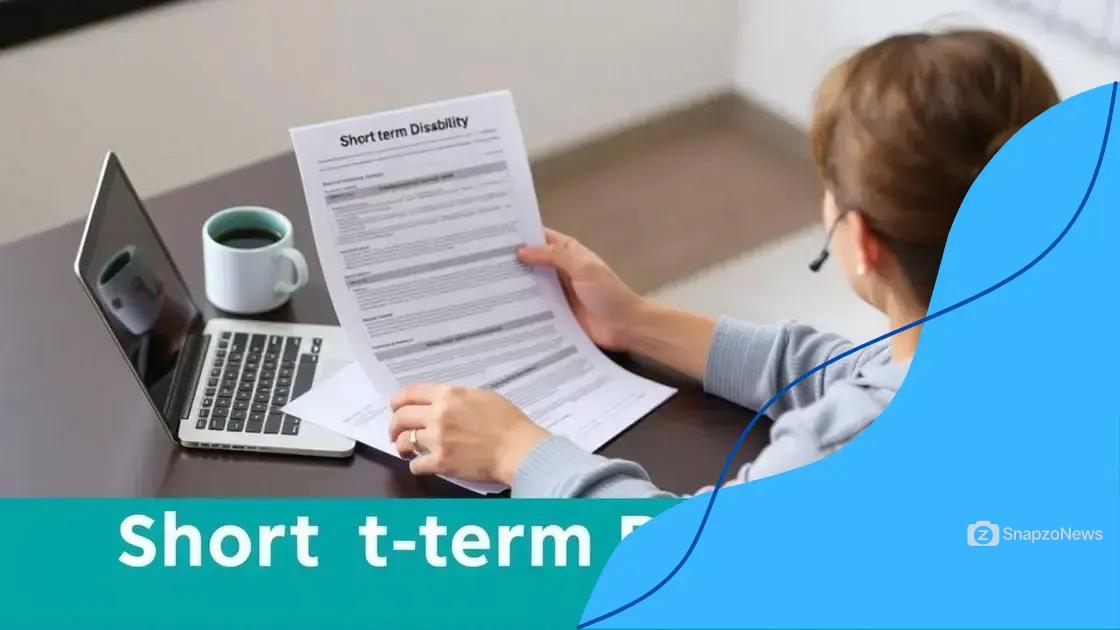Navigating the complexities of short-term disability

Navigating the complexities of short-term disability involves understanding eligibility, applying correctly, and managing finances while ensuring you gather all necessary documents and know your rights to receive benefits.
When facing a situation that requires Navigating the complexities of short-term disability, many find themselves overwhelmed. It’s crucial to grasp the ins and outs of this often misunderstood area to ensure you receive the support you need. Ready to dive deeper?
Understanding short-term disability benefits
Understanding short-term disability benefits is essential for anyone facing a temporary inability to work due to medical reasons. These benefits can provide financial support during a difficult time, but many people are unsure how they work or whether they qualify.
What are short-term disability benefits?
Short-term disability benefits are designed to replace a portion of your income when you cannot work for a limited time due to a medical condition. This can include recovery from surgery, serious illness, or injury. Typically, these benefits last for a few weeks to a few months, depending on the policy.
Eligibility criteria
To qualify for short-term disability benefits, you often need to meet specific criteria:
It’s essential to check with your employer or insurance provider to understand the details of your specific plan. Some policies have a waiting period, which means you must be disabled for a certain number of days before benefits kick in. This waiting period can vary, so be sure to stay informed.
Different types of plans
There are various types of short-term disability plans available to workers. A few common options include:
Each plan has unique terms regarding benefits, eligibility, and duration, so it’s crucial to read the fine print. Having a clear understanding allows you to prepare better for unexpected situations.
Remember, navigating through the world of short-term disability benefits can seem overwhelming, but understanding your options makes it much easier. Seek out advice from HR personnel or financial advisors if needed, and don’t hesitate to ask questions about your coverage. The right knowledge can empower you and alleviate some of the stresses associated with unforeseen medical issues.
Eligibility criteria for short-term disability
Eligibility criteria for short-term disability benefits vary by policy and provider. It’s essential to understand these criteria to determine if you can receive financial support during your recovery.
Common eligibility requirements
Generally, to qualify for short-term disability benefits, you must meet several common requirements:
Different employers and insurers have varied rules. For instance, some short-term disability plans require an employee to have worked for a minimum period, such as 12 months, before they can claim benefits. Others may have a shorter waiting period. Always check your specific policy details to ensure you have a clear understanding.
Understanding the definition of disability
Defining what constitutes a disability can also impact eligibility. Often, a disability is considered a physical or mental health condition that significantly impairs your ability to work. Factors that can affect this definition include:
To strengthen your claim for short-term disability, keep thorough documentation of your condition. Having clear records can help clarify your situation when applying for benefits.
Finally, if your claim is denied, don’t get discouraged. Many claims are denied initially due to missing paperwork or incorrect information. You can appeal the decision, often with the help of your employer’s HR department or a medical professional who understands the process.
How to apply for short-term disability

Applying for short-term disability benefits may seem daunting, but breaking it down into steps can make the process easier. Understanding what you need to do is key to receiving the support you need.
Gather necessary documentation
Before starting your application, it’s crucial to collect all required documents. Some important items to prepare include:
Having these documents ready will streamline the application process and prevent delays. Make sure to check if your employer requires specific forms.
Complete the application form
Once you have your documents, fill out the application form thoroughly. Pay attention to the details and make sure not to leave any sections blank. If applicable, include:
Double-check your application to ensure accuracy. Mistakes can lead to delays or even denials of your claim.
Submit your application
After completing the application, submit it according to your employer’s guidelines. This might involve sending it directly to your HR department, a specific insurance company, or an online portal. Be sure to keep a copy of everything you send in. Once submitted, follow up to confirm that your application was received. Understanding the next steps can help ease any worries during this time.
Lastly, be patient as you await a response. Processing times can vary, but knowing you’ve taken the necessary steps will give you some peace of mind as you deal with your recovery.
Common misconceptions about short-term disability
Common misconceptions about short-term disability can lead to confusion and misunderstandings. Many people have questions that can affect their knowledge and decisions regarding benefits.
Misconception 1: It only covers physical injuries
One common myth is that short-term disability only applies to physical injuries. In reality, it can also cover mental health conditions, surgeries, and chronic illnesses. This means that a wide range of medical conditions can qualify for benefits.
Misconception 2: You must be completely unable to work
Many believe they need to be completely unable to work to qualify for short-term disability. However, if a medical condition limits your ability to perform specific tasks, you may still be eligible. Disability benefits focus on your ability to fulfill job requirements, not your overall capacity.
Misconception 3: It’s an easy process with instant approval
Another misconception is that applying for benefits is straightforward and that all applications are quickly approved. While some claims are approved quickly, others may take time. Processing involves verification of documentation from medical professionals and employers, which can lead to delays. Be prepared for a potentially lengthy process, and ensure that you complete your application correctly.
Many people also think that their employer will automatically inform them about their eligibility for benefits. It’s important to actively seek this information, as every company may have different policies. Always check with your HR department if you have questions about your coverage.
Misconception 4: Benefits last forever
Some believe that once they qualify for short-term disability, they will receive benefits indefinitely. However, short-term disability typically lasts for a limited time, often between three to six months. Knowing the duration of your benefits can help you plan financially and emotionally during your recovery.
Ultimately, addressing these misconceptions is crucial for effectively navigating the short-term disability system. Being informed will empower you to take the right steps and understand your rights and options.
Managing finances during short-term disability
Managing finances during short-term disability can be challenging, especially if you rely heavily on your regular income. Understanding how to budget can help ease some financial stress during this period.
Identify your essential expenses
Start by listing all your essential expenses. This includes:
Knowing your mandatory monthly costs allows you to prioritize where your money goes. It’s crucial to cover these essentials first to maintain stability while you recover.
Review your short-term disability benefits
Check to see how much financial support you’ll receive from your short-term disability benefits. These benefits may replace a percentage of your income, often around 60-70%. Understanding this amount helps you determine how much of your total income is still available.
Create a new budget
Based on your essential expenses and expected income, adjust your budget accordingly. Here are some tips to consider:
Establishing a new budget can help ensure that you can manage your finances effectively during recovery.
Explore additional financial resources
If you’re struggling to make ends meet, look into additional financial resources. Some options include:
These resources can provide temporary relief and help you through this challenging time.
Finally, communicating with family and friends can also be beneficial. They might be able to offer support or advice based on their experiences. Being open about your situation can help alleviate some of the burdens you may be feeling during your recovery.
In conclusion, navigating the complexities of short-term disability requires understanding the benefits available, how to apply, and managing finances during your recovery. By addressing common misconceptions and being prepared, you can ensure that you get the support you need. Remember to gather necessary documents, assess your expenses, and explore all available resources to make this challenging time a little easier. Stay informed, and don’t hesitate to reach out for help when needed.
FAQ – Frequently Asked Questions about Short-Term Disability
What is short-term disability?
Short-term disability is a type of insurance that provides income replacement if you are unable to work due to a medical condition for a limited time.
How do I apply for short-term disability?
To apply, gather necessary documents such as medical records and a doctor’s note, then complete your employer’s application form.
What are the eligibility criteria for short-term disability benefits?
Eligibility often requires you to have a medical condition that prevents you from working, and you may need to have worked for your employer for a certain period.
How can I manage my finances while on short-term disability?
Create a budget by identifying essential expenses, adjusting to the reduced income, and exploring additional financial resources if needed.
